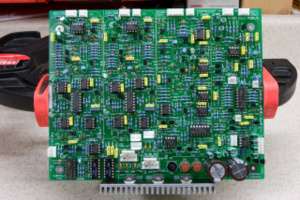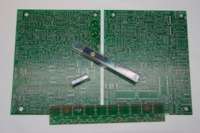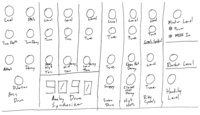
About
The 9090 is a clone of the synthesizer portion of the legendary Roland TR-909, with a few small usability improvements.
Trevor Page (the 9090's designer) explains it best on 9090 site itself at introspectiv.org:
- The 9090 is an analogue drum machine based upon the legendary Roland TR-909 Rhythm Composer. Many people consider this machine to be the life and soul of house music and it's modern derivatives. Trance, techno, whatever. In some moment of insanity back in '99 I decided it would be a fun challenge to build an entire clone of this classic analogue drum box (having no appreciation of how such a project can take over your life) and, bored with using sampled beats, I wanted a real, tweakable analogue box. Just like the 909.
- I chose to make my 9090 just a MIDI controlled unit without an integral sequencer. All original drums are in there, together with power supply and a new PIC-based MIDI interface. The complete project is built across two separate printed circuit boards, designed to fit within a 2U height 19" rack enclosure. I didn't develop a sequencer to go with this, but I'll do it if I get the time.
- The voice circuits used within the clone remain faithful to those of the original machine. In other words they remain mostly unchanged, except where I've added controls for extra tweakage. Most semiconductors have been substituted for modern equivalents that are more easily available. Most of the TR-909 sounds are completely analogue and hence some pretty intricate discrete circuitry is involved. Only the hi-hat and cymbal are 'digital' since the TR-909 used samples contained within three 32K ROMs for these.
Differences from TR-909
The differences between an original TR-909 and the 9090 are described at introspectiv.org as follows:
- A small number of modifications were included to further enhance the 9090's capabilities, mainly in the form of extra potentiometers. The arrangement of knobs on the front panel is similar to that on the TR-909, but you can probably spot a few new ones on there.
- In particular the versatile Bass Drum has several additional controls. Pitch sets the initial pitch. Tune Decay (formerly Tune) sets the speed at which the pitch is swept (lowered) as the drum sounds, and Tune Depth sets the sweep amount. Rotating the Tune Depth control clockwise produces a lowered final pitch. Manipulating the Pitch, Tune Decay, and Tune Depth settings can produce a bass drum ranging from relatively flat sounding, to a very energetic, punchy kick that really cuts through the mix.
- A Bass Drum Distortion control causes an increasing clipping effect as it is rotated clockwise. This simple addition takes advantage of the diode clamp circuit that ‘rounds off’ the triangle wave from the VCO, by overdriving the diodes to produce a more square, overdriven sounding wave.
- A Tune control has been added to the Hi-Hat voice. This affects both open and closed-hat sounds together. It works in the same way as the tune control for crash and ride cymbals.
MIDI
Lacking an internal sequencer, the 9090 has a MIDI interface. Again, from at introspectiv.org:
- The 9090 has a complete MIDI interface, implemented with a PIC microcontroller. Drum sounds are assigned to individual keys and are velocity sensitive. By means of a Configure button, MIDI channel and note assignment (how the drum sounds are assigned to various notes across the keyboard) can be altered using MIDI messages. A MIDI Thru jack allows chaining of further MIDI instruments via the 9090. A useful MIDI LED provides visual indication of all data, with the exception of clock information.
- A handy MIDI to DIN Sync interface was included for good measure simply because I needed one to synchronise my TB-303 with the MIDI clock. Two DIN Sync outputs are located next to the MIDI sockets, providing a fixed 24PPQN signal.

Kit
The 9090 kit is available for purchase directly from Trevor Page at introspectiv.org for US$100, including postage to the US. This kit includes all three PCBs, sample ROMs, and PIC microcontroller.
Photographs of the 9090 kit which I received, including packaging, can be found here. Detailed scans of the 9090 PCBs themselves are available here.
Remember that this kit requires one to select and purchase most of the components themselves. While the 9090 Parts List is available, it does not call out individual part numbers. There are some BOMs which are available though the introspectiv Yahoo! Group, but they do not appear to be completely accurate. Assembly of this kit takes quite a bit of time, especially selecting and ordering parts.

Enclosure
While I really like the look of Trevor Page's 2U rackmount 9090 enclosure, it's not quite what I want. I think I more want a desktop-type enclosure, so I'm probably going to use one of the Hammond Sloped Steel & Aluminum Consoles. If designed correctly these should allow me to place all required controlls on the face while still providing room for the power supply transformer and all inputs and outputs on the rear panel.
Status
Fitting of parts to the 9090 PCBs is complete. Images of the completed PCBs are available here: PC001 including heatsink, PC002 (except for missing caps and CA3080), output jack board.
Front panel and enclosure design are now underway. I've now sold the completed 9090 boards.
Sold
On 17-Aug-2007 I sold the completed 9090 boards. I found that I didn't want to complete the project, and even if I did it likely wouldn't get used, so I sold it to someone local who is ready to assemble the enclosure for a bit more than the cost of the parts. I probably undercharged a bit, but it sold quickly and the buyer seems pretty happy about it.
Documentation
These files are copies of the PDF documents from Trevor Page's 9090 site. They are mirrored here so I won't accidently lose them should the site go away before I finish building mine.
- 9090 Users Guide
- 9090 Parts List
- 9090 Wiring Guide
- 9090 Board Layouts (Silkscreen layer from two main PCBs.)
- Original 9090 Schematics
- 9090 Schematics w/ Correct Output Socket Labeling
- Corrected Output Socket Schematic
Firmware / ROMs
These are mirrors of the firmware and ROMs from the introspectiv Yahoo! Group, just to help keep them from becoming lost to the ether.
- Firmware for MIDI Input v1.2 (for 16F84-04)
- ASM Source for MIDI Input Firmware v1.2
- TR-909 Crash Cymbal ROM
- TR-909 High Hat Cymbal ROM
- TR-909 Ride Cymbal Sample ROM
External Links
- introspectiv.org - Trevor Page's Project 9090 site.
- Wikipedia Entry for TR-909
- Thomas Kolb's page about his TR-909
- introspectiv Yahoo! Group - For builders of the 9090.